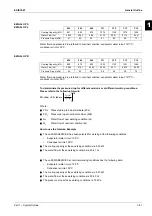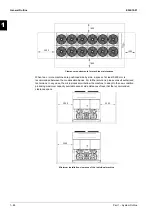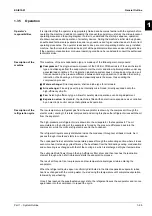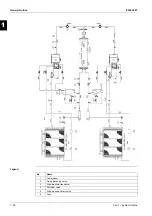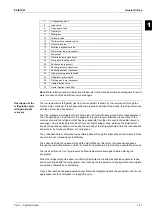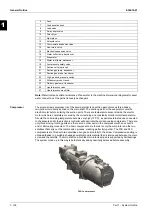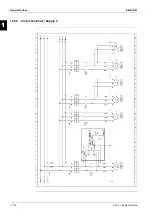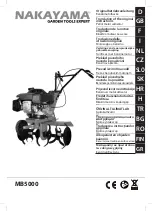
ESIE10-01
General Outline
1–95
3
1
4
5
1.35
Operation
Operator's
responsibilities
It is important that the operator is appropriately trained and becomes familiar with the system before
operating the machine. In addition to reading this manual, the operator must study the microprocessor
operating manual and the wiring diagram in order to understand the start-up sequence, operation,
shut-down sequence and operation of all safety devices. During the machine's initial start-up phase,
an authorised technician is available to answer any questions and to give instructions as to the correct
operating procedures. The operator is advised to keep a record of operating data for every installed
machine. Another record should also be kept of all the periodical maintenance and servicing activities.
If the operator notes abnormal or unusual operating conditions, he is advised to consult the authorised
technical service.
Description of the
machine
This machine, of the air-condensation type, is made up of the following main components:
Q
Compressor:
The single-screw compressor of the FR3B or FR4A series is of the semi-hermetic
type and utilises gas from the evaporator to cool the motor and allow optimal operation under any
expected load conditions. The oil-injection lubrication system does not require an oil pump as oil
flow is ensured by the pressure difference between delivery and suction. In addition to ensuring
lubrication of ball bearings, oil injection dynamically seals the screw, thus enabling the
compression process.
Q
Water exchanger:
Direct expansion, shell and tube type for all models.
Q
Air exchanger:
Finned type with pipes, internally micro-finned, directly expanded onto the
high-efficiency strip fin.
Q
Fan:
Axial, high-efficiency type. Allows for quiet system operation even during adjustment.
Q
Expansion valve:
As standard, the machine is fitted with an electronic expansion valve controlled
by an electronic control device that optimises its operation.
Description of the
refrigeration cycle
The low-temperature refrigerant gas from the evaporator is drawn by the compressor through the
electric motor, cooling it. It is later compressed, and during this phase the refrigerant mixes with the oil
from the separator.
The high-pressure oil-refrigerant mix is drawn into the oil separator, that separates it. The oil
accumulated on the bottom of the separator is forced by the pressure difference back into the
compressor, while the oil-free refrigerant is sent to the condenser.
The refrigerant liquid is evenly distributed inside the condenser throughout all bank circuits. As it
passes through it cools and starts to condense.
The condensed fluid at saturation temperature passes through the subcooling section where it loses
even more heat, increasing cycle efficiency. The heat taken from the fluid during cooling, condensation
and subcooling is exchanged with that of the cooling air, which is discharged at higher temperatures.
The subcooled fluid flows through the high-efficiency filter dryer and then reaches the lamination
element through which a fall in pressure starts the evaporation process.
The result at this point is a low-pressure and low-temperature liquid-gas mixture entering the
evaporator.
When the refrigerant liquid-vapour is uniformly distributed in the direct expansion evaporator tubes,
heat is exchanged with the cooling water, thus reducing the temperature until complete evaporation,
followed by superheating.
Once it has reached the superheated-vapour state, the refrigerant leaves the evaporator and is once
again taken into the compressor to repeat the cycle.
Summary of Contents for EWAD620-C17C-SL
Page 2: ......
Page 8: ...ESIE10 01 1 2 Part 1 System Outline 3 1 1 5 ...
Page 111: ...ESIE10 01 General Outline Part 1 System Outline 1 105 3 1 4 5 1 36 1 Power Compressor 1 2 ...
Page 112: ...General Outline ESIE10 01 1 106 Part 1 System Outline 3 1 1 4 5 1 36 2 Power Compressor 3 ...
Page 113: ...ESIE10 01 General Outline Part 1 System Outline 1 107 3 1 4 5 1 36 3 Kit Pumps ...
Page 122: ...General Outline ESIE10 01 1 116 Part 1 System Outline 3 1 1 4 5 1 36 12 Digital Inputs Board ...
Page 123: ...ESIE10 01 General Outline Part 1 System Outline 1 117 3 1 4 5 1 36 13 Digital Outputs Board ...
Page 124: ...General Outline ESIE10 01 1 118 Part 1 System Outline 3 1 1 4 5 1 36 14 Digital Outputs Board ...
Page 131: ...ESIE10 01 General Outline Part 1 System Outline 1 125 3 1 4 5 1 36 21 EEXV Compressor 1 ...
Page 134: ...General Outline ESIE10 01 1 128 Part 1 System Outline 3 1 1 4 5 1 36 24 EEXV Compressor 2 ...
Page 137: ...ESIE10 01 General Outline Part 1 System Outline 1 131 3 1 4 5 1 36 27 EEXV Compressor 3 ...
Page 138: ...General Outline ESIE10 01 1 132 Part 1 System Outline 3 1 1 4 5 1 36 28 Pumps Control ...
Page 139: ...ESIE10 01 General Outline Part 1 System Outline 1 133 3 1 4 5 1 36 29 Terminals M1 M2 ...
Page 140: ...General Outline ESIE10 01 1 134 Part 1 System Outline 3 1 1 4 5 1 36 30 Terminals M3 ...
Page 141: ...ESIE10 01 General Outline Part 1 System Outline 1 135 3 1 4 5 1 36 31 Terminals M5 MQ ...
Page 148: ...General Outline ESIE10 01 1 142 Part 1 System Outline 3 1 1 4 5 ...
Page 150: ...ESIE10 01 2 2 Part 2 Functional Description 3 1 2 5 ...
Page 170: ...The Digital Controller ESIE10 01 2 22 Part 2 Functional Description 3 1 2 4 5 ...
Page 200: ...Functional Control ESIE10 01 2 52 Part 2 Functional Description 3 1 2 4 5 ...
Page 202: ...ESIE10 01 3 2 Part 3 Troubleshooting 3 1 3 5 ...
Page 254: ...Alarms and Events ESIE10 01 3 54 Part 3 Troubleshooting 3 1 3 4 5 ...
Page 266: ...Controller Inputs and Outputs ESIE10 01 3 66 Part 3 Troubleshooting 3 1 3 4 5 ...
Page 280: ...ESIE10 01 4 2 Part 4 Commissioning and Test Run 3 1 4 5 ...
Page 286: ...Pre Test Run Checks ESIE10 01 4 8 Part 4 Commissioning and Test Run 3 1 4 5 ...
Page 289: ...ESIE10 01 Running Data Part 4 Commissioning and Test Run 4 11 3 4 5 1 ...
Page 290: ...Running Data ESIE10 01 4 12 Part 4 Commissioning and Test Run 3 1 4 5 ...

